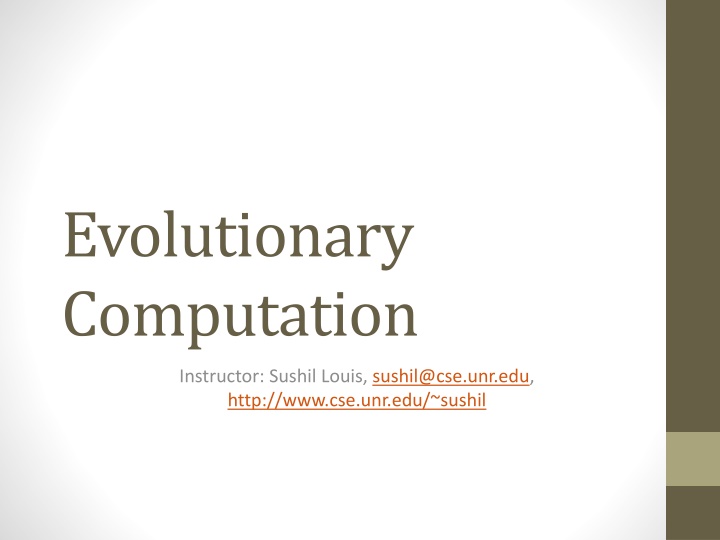Evolutionary Computation Explained Through Genetic Algorithms
Explore the world of evolutionary computation with a focus on genetic algorithms. Learn how non-classical search and model evaluation contribute to maximizing objective functions. Delve into the detailed process of generating and evaluating populations, selection techniques, and the key aspects of genetic algorithms. Gain insights into fitness evaluation, roulette wheel selection, and more.
Download Presentation

Please find below an Image/Link to download the presentation.
The content on the website is provided AS IS for your information and personal use only. It may not be sold, licensed, or shared on other websites without obtaining consent from the author.If you encounter any issues during the download, it is possible that the publisher has removed the file from their server.
You are allowed to download the files provided on this website for personal or commercial use, subject to the condition that they are used lawfully. All files are the property of their respective owners.
The content on the website is provided AS IS for your information and personal use only. It may not be sold, licensed, or shared on other websites without obtaining consent from the author.
E N D
Presentation Transcript
Evolutionary Computation Instructor: Sushil Louis, sushil@cse.unr.edu, http://www.cse.unr.edu/~sushil
Non-classical search - Path does not matter, just the final state - Maximize objective function
Model We have a black box evaluate function that returns an objective function value Obj. func candidate state Evaluate Application dependent fitness function
More detailed GA Generate pop(0) Evaluate pop(0) T=0 While (not converged) do Select pop(T+1) from pop(T) Recombine pop(T+1) Evaluate pop(T+1) T = T + 1 Done
Generate pop(0) Initialize population with randomly generated strings of 1 s and 0 s for(i = 0 ; i < popSize; i++){ for(j = 0; j < chromLen; j++){ Pop[i].chrom[j] = flip(0.5); } }
Genetic Algorithm Generate pop(0) Evaluate pop(0) T=0 While (not converged) do Select pop(T+1) from pop(T) Recombine pop(T+1) Evaluate pop(T+1) T = T + 1 Done
Evaluate pop(0) Fitness Decoded individual Evaluate Application dependent fitness function
Genetic Algorithm Generate pop(0) Evaluate pop(0) T=0 While (T < maxGen) do Select pop(T+1) from pop(T) Recombine pop(T+1) Evaluate pop(T+1) T = T + 1 Done
Genetic Algorithm Generate pop(0) Evaluate pop(0) T=0 While (T < maxGen) do Select pop(T+1) from pop(T) Recombine pop(T+1) Evaluate pop(T+1) T = T + 1 Done
Selection Each member of the population gets a share of the pie proportional to fitness relative to other members of the population Spin the roulette wheel pie and pick the individual that the ball lands on Focuses search in promising areas
Code int roulette(IPTR pop, double sumFitness, int popsize) { /* select a single individual by roulette wheel selection */ double rand,partsum; int i; partsum = 0.0; i = 0; rand = f_random() * sumFitness; i = -1; do{ i++; partsum += pop[i].fitness; } while (partsum < rand && i < popsize - 1) ; return i; }
Genetic Algorithm Generate pop(0) Evaluate pop(0) T=0 While (T < maxGen) do Select pop(T+1) from pop(T) Recombine pop(T+1) Evaluate pop(T+1) T = T + 1 Done
Crossover and mutation Mutation Probability = 0.001 Insurance Xover Probability = 0.7 Exploration operator
Crossover code void crossover(POPULATION *p, IPTR p1, IPTR p2, IPTR c1, IPTR c2) { /* p1,p2,c1,c2,m1,m2,mc1,mc2 */ int *pi1,*pi2,*ci1,*ci2; int xp, i; pi1 = p1->chrom; pi2 = p2->chrom; ci1 = c1->chrom; ci2 = c2->chrom; if(flip(p->pCross)){ xp = rnd(0, p->lchrom - 1); for(i = 0; i < xp; i++){ ci1[i] = muteX(p, pi1[i]); ci2[i] = muteX(p, pi2[i]); } for(i = xp; i < p->lchrom; i++){ ci1[i] = muteX(p, pi2[i]); ci2[i] = muteX(p, pi1[i]); } } else { for(i = 0; i < p->lchrom; i++){ ci1[i] = muteX(p, pi1[i]); ci2[i] = muteX(p, pi2[i]); } } }
Mutation code int muteX(POPULATION *p, int pa) { return (flip(p->pMut) ? 1 - pa : pa); }
How does it work? Toy example, hand cranked Maximize f(x) = x^2 in the range [0 .. 31] Binary representation is simple 00000 0 00001 1 11111 31 Population size 4 maxGen = 2
How does it work String decoded f(x^2) fi/Sum(fi) Expected Actual 01101 11000 01000 10011 13 24 8 19 169 576 64 361 0.14 0.49 0.06 0.31 0.58 1.97 0.22 1.23 1 2 0 1 Sum Avg Max 1170 293 576 1.0 .25 .49 4.00 1.00 1.97 4.00 1.00 2.00 17
How does it work contd String mate offspring decoded f(x^2) 0110|1 1100|0 11|000 10|011 2 1 4 3 01100 11001 11011 10000 12 25 27 16 144 625 729 256 Sum Avg Max 1754 439 729 18
Randomized versus Random versus Deterministic search algorithms We want fast, reliable, near-optimal solutions from our algorithms Reliability Speed Performance Deterministic Search once Random Average over multiple runs Randomized hill climber, GA, SA, Average over multiple runs We need reproducible results so understand the role of the random seed in a random number generator
Representations Why binary? Later Multiple parameters (x, y, z ) Encode x, encode y, encode z, concatenate encodings to build chromosome As an example consider the DeJong Functions And now for something completely different: Floorplanning TSP Later JSSP/OSSP/ Later
Representations DeJong Functions F1: Minimize: Multiple parameters (x1, x2, x3, x4, x5) Encode x1, encode x2, encode x3, concatenate encodings to build chromosome F2: Minimize: And now for something completely different: Floorplanning

